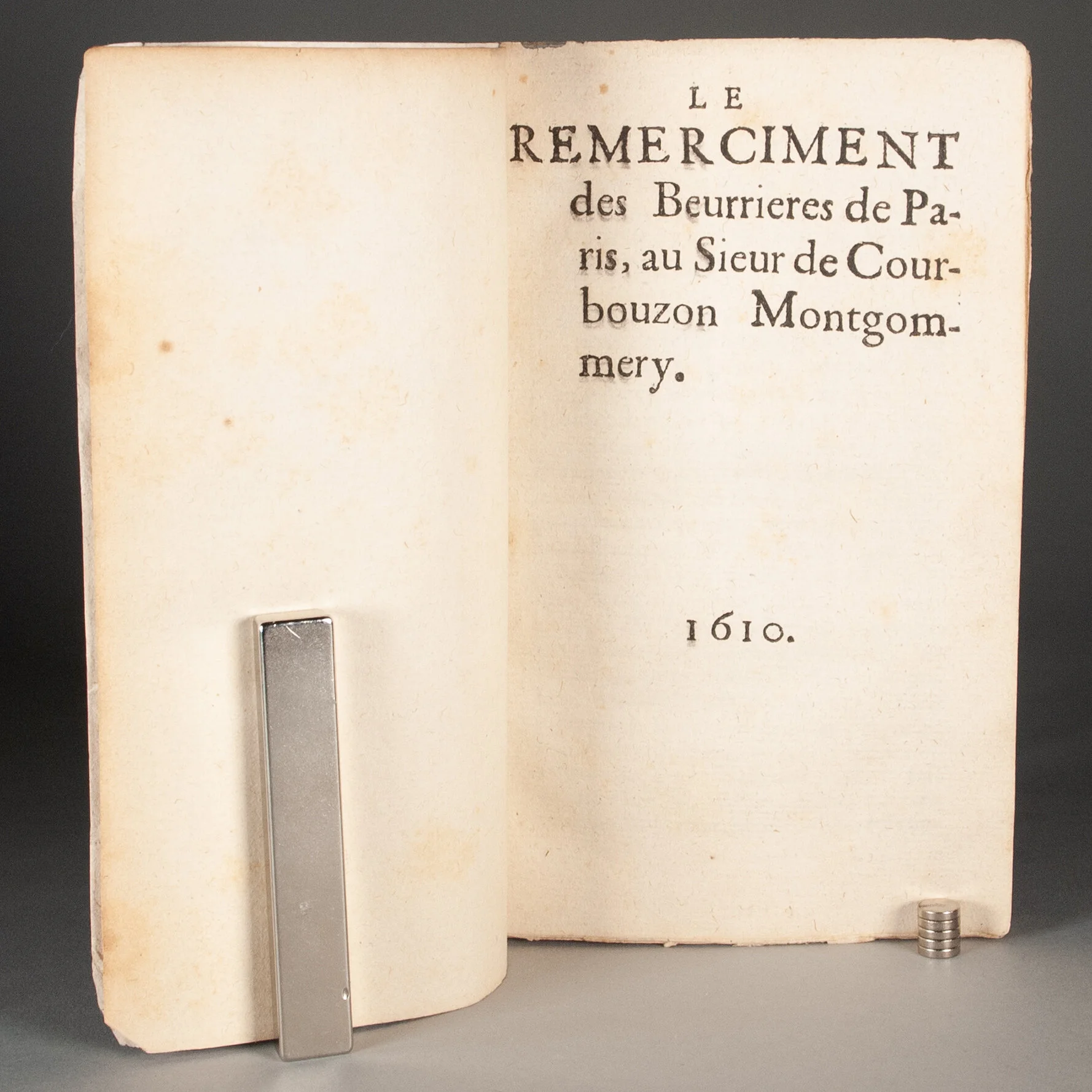Jesuit butter seller satire



Jesuit butter seller satire
Le remerciment des beurrieres de Paris, au Sieur de Courbouzon Montgomery [bound with] Le fleau d'Aristogiton, ou contre le calomniateur des Peres Jesuites soubs le tiltre d'Anticoton
the latter by Louis de Montgommery
Le remerciment: France? 1610 | Le fleau: France, 1610?
29, [3]; 15, [1] p. | 8vo | A-D^4; A-B^4 | 169 x 104 mm
Both are among several editions published in 1610, each boasting a Dutch translation too, all part of a Protestant-Jesuit pamphlet war that accelerated after the 1610 assassination of Henri IV. Our Le fleau is not the 1610 Paris Rousselet edition, nor the 1610 Amsterdam Colin edition, nor the 1610 edition “after the Paris copy” (this also included in the 1611 Recueil de plusieurs escrits publiez). We wonder if it might match OCLC 1055688964, which lacks a title page, and/or the 15-page edition at the Cantonal and University Library of Lausanne, which also seems to lack a title. ¶ Dressed up as a satirical thank-you note from the guild of Paris butter sellers, the anti-Jesuit Le remerciment attacks Louis de Montgommery and his Le fleau, which itself had attacked the anonymous Anti-Cotton, “the most forceful of the anti-Jesuitical pamphlets” (Rothrock). While Henri IV’s assassination certainly catalyzed the debate, it had roots in longstanding unease some French harbored toward the Jesuit influence in their country, the 1589 assassination of Henri III by a Dominican friar not yet distant past. Henri IV approached his faith with a politician’s pragmatism, starting as a Protestant and later converting to Catholicism. Pierre Coton, Jesuit confessor to Henri IV and target of Anti-Cotton, adopted an attitude of relative tolerance like his king. “It would appear that Father Coton was a moderate crucified to satisfy extremist emotions. Too gentle in his criticism of Mariana”—a Spanish Jesuit who approved tyrannicide in his 1598 De rege et regis institutione—“and too circumspect in his defense of his Order, he made matters rather worse than better. He was not left to defend his cause alone, however, for other pamphlets were published by or in support of the Jesuits.” Here are two such pamphlets, one advocating for each side, one responding directly to the other. ¶ The anonymous author of Le remerciment certainly embraces juvenile and hateful insults. “Greek history teaches us that Aristogiton was a Sodomite who had Harmodius for his partner [bardache],” we read. “This vice is common among the Jesuits” (p. 13). He also takes on the proto-feminist Marie de Gournay. His flailing, puerile, contradictory misogyny leads him to call her a 55-year-old virgin (p. 8: pucelle de cinquante cinq ans), but not before casting her as a whore (p. 3: qui a tousiours bien servi au public). Yet there’s evidence of a deep anxiety, as if the Jesuits were the fifth column in some vast conspiracy, hiding dark motives behind their impenetrable erudition. Indeed, Latin is a particular preoccupation with the author, who expects the Jesuits wouldn’t have him understand it “any more than high German,” further suggesting that through Latin they “wish to make the most stupid people [plus sots] believe that they have accomplished marvels” (p. 11). He calls out the Jesuits for claiming that Henri III’s assassin could not have understood any of their Latin work that might have spurred him to crime—“as if the Jesuits in their secret meetings, and in the confession made to Father Daubigny, have never spoken in obscure Latin” (p. 20). The rhetorical function of masquerading as butter sellers remains unclear to us, and the pretense is only weakly carried through the pamphlet. Perhaps it was simply to pit the mass of unschooled laborers against the learned elite? ¶ We find a single copy of our edition of Le remerciment in North America (Newberry), and several each of the Niort and Sedan editions. Among North American libraries, only Florida Atlantic University has a copy of what might be our Le fleau.
PROVENANCE: Pierre Coton’s name has been struck through on p. 29, so perhaps this copy belonged to a reader sympathetic to the Calvinist cause.
CONDITION: Early marbled wraps, perhaps 18th-century, possibly 17th-century. Last leaf in Le remerciment is blank. ¶ Le fleau lacks a title leaf, possibly as issued. Lightly foxed; small burn mark in leaf D2 of Le remerciment. Wraps gently worn at the extremities.
REFERENCES: Le remerciment: USTC 6017891 or 6017892; Gay and Lemonnyer, Bibliographie des ouvrages relatifs a l’amour, aux femmes et au mariage, 4th ed (Lille, 1899), v. 3, col. 999 (also citing the Niort edition); Carlos Sommervogel, Bibliothèque de la Compagnie de Jésus (1891), v. 2, col. 1550 (five editions cited, but not this one) ¶ Le fleau: Sommervogel, v. 2, col. 1549 (cites five editions, including one of 15 p.) ¶ George A. Rothrock, Jr., “The Gallican Resurgence after the Death of Henry IV,” The Historian 24.1 (November 1961), p. 6, 8-9; Emily Butterworth, “’Ces caustiques babils’ : Marie de Gournay’s Response to Slander,” Intellectual News 11/12.1 (2003), p. 48 (“Following the assassination of Henri IV, her support of the Jesuit cause in the 1610 Adieu de l’ame du roy de France…made her the brunt of a satirical pamphlet, L’anti Gournay, which slandered her virtue rather than her writing. She attempted to suppress this libel through the courts without success.”); Marie-Thérèse Noiset, “Marie de Gournay et le caprice des siècles,” Études françaises 29.3 (1993), p. 197n12
Item #349
